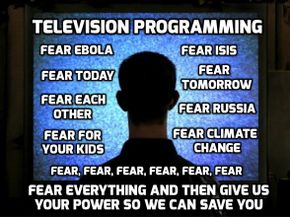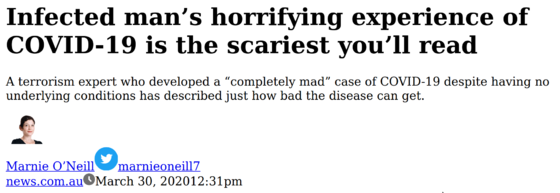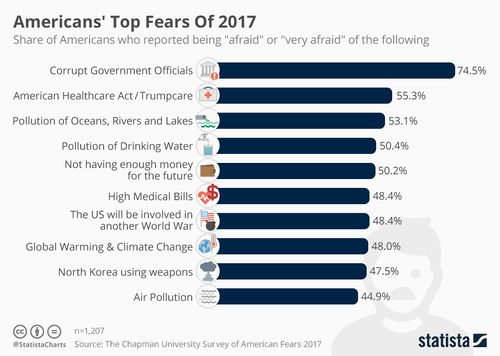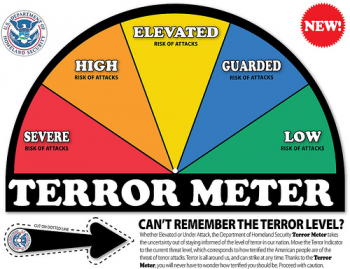Fear
(Social control) | |
|---|---|
 | |
| Type | psychological |
| A mental state which is not only unpleasant but demonstrably damaging to body and mind. Its has been used since antiquity for purposes of social control. In the 21st century, this is increasingly centered on the "war on terror" and "extremism" narratives. | |
“We must build dikes of courage to hold back the flood of fear.”
MLK [1]
Fear, and its less acute associated emotion, stress, have been extensively studied by intelligence agencies to facilitate their effective exploitation to achieve deep political ends, through methods such as the strategy of tension, applied by NATO's Operation Gladio and Operation Gladio/B projects. People's enemy images have been nurtured, sometimes over generations (for example, based on race or nationalism), a tactic which is proving unstable given the increase in global inter-communication arising from the internet.
“There are two ways in which people are controlled: first of all frighten them, and then demoralise them. An educated healthy, and confident nation is harder to govern.”
Tony Benn [2]
Contents
Physiological effects
Acute fear is an emotion which promotes the release of stress hormones such as adrenaline, cortisol and norepinephrine. These increase heart rate and muscle strength by diverting resources away from longer term survival needs such as reproductive drive, immunity, digestion and growth. While this facilitates the body's natural "fight or flight" response system which facilitates handling of immediate threats.[3] These stress hormones are a natural but maladaptive response to the sort of chronic stress endemic in most parts of the world. It is a moot point to what extent this has been deliberately engineered as a means of social control.
War on Terror
- Full article:
 “War on Terror”
“War on Terror”
- Full article:
The "war on terror" - which less disingenuously could be called a "war of terror" - is a strategy of tension which aims to subject a population and stifle opposition by promoting fear of "terrorism". After 9/11, the anti-globalization movement was suffered a crucial blow because “Some of the NGOs and nonprofits were really worried about seeming un-American... [which reversed the trend of increasing numbers at protests]... the anti-globalization movement never made a comeback."[4]
While the number of direct fatalities of the war on terror is relatively small, approximately 0.25% of the number of people killed by road accidents[5] the unlikeliness of being personally affected does not stop people's fear response being engaged, especially when the commercially-controlled media give saturation coverage of "terrorism". The number of direct victims need only be a tiny fraction of the victimised population if commercially-controlled media is on board with the project of stoking fear. Citizens in the USA are more afraid of "terrorism" than any other national population.[6]
Big media & The "Culture of fear"
Jeff Schechtman refers to a "culture of fear in the United States" while Sasha Ambramsky claims that small fears that are used, in conjunction with the commercially-controlled media, to amplify what he terms the “fog of fear.” [7] This leads to misperceptions of risk. A 2015 a Gallup poll showed 70% of US respondents believe crime has gone up since 2014, with 63% reporting crime had risen from 2013 levels.[8]
Sarah Sands, later editor of the BBC's Radio 4 Today programme, authored a revealing policy memo in the mid 1990s while working for The Telegraph. In it she urged the editor, Charles Moore to "play on people's fears." She wrote that "the middle classes want to read about unemployment and negative equity and juvenile delinquency. We should be basically friendly and fair minded but then take people aback with ferocious militia-style attacks ... the Mail gets the best out of people through fear."[9]
Illustrations

Overall, social engineering is most advanced in the USA, so this is a particularly informative society in which to note the importance of fear.
Panic about COVID-19
- Full article: COVID-19/Panic
- Full article: COVID-19/Panic

COVID-19 is a respiratory illness caused by a coronavirus similar to influenza. It has a survival rate of well over 99% and is not particularly deadly for the young and healthy. Nevertheless, in early 2020 it was presented as a killer pandemic and Tedros Ghebreyesus quoted an infection fatality rate of 3.4%. Commercially-controlled media consistently played up fear of the virus.
Fear of Mass shootings
In 2018, the majority of US teenagers were worried about the possibility of a mass shooting. A WhoWhatWhy article was entitled In 2019, Active Shooter Drills Are The New Fire Drills In Schools.[10]
Fear of "terrorism"

In the 21st century, the public of many nations are constantly reminded of the need to be 'alert' or 'vigilant' for potential "terrorists". This, despite the fact that "terrorism" poses a tiny actual danger when compared to events such as traffic accidents[12] and the more serious long term problems such as emerging diseases or climate change.
Fear of safety of children
In the last generation, fear for the safety of children in USA has mushroomed.[13] In 2015 in the USA two adults discovered a neighbour's 4-year-old child playing alone at an outdoor playground, less than 50 metres from his front door. When he refused to go home as he wasn't finished playing, their fear for his safety lead them to call the police. The police declared that they thought the mother's behaviour amounted to criminal neglect. The "justice" system seems likely to decree said that his mother must serve months in jail (prosecutors rejected a month plea deal). As her lawyer noted, had the incident happened 20 years ago, no one would have been charged and the police would not have been called.[14]
Fear of "corrupt government officials"
In USA, an annual poll of the public's fears revealed #1 to be fear of "corrupt government officials", which in 2017 stood at 75%, up 15% from 2016. This correlates with a 2014 academic study which concluded that US is a de facto dictatorship - that the will of the public is not correlated with which legislation gets passed.[15]
Examples
| Page name | Description |
|---|---|
| "Raising awareness" | To raise awareness (to threats) if aired by politicians and commercially-controlled media is, in deep politics, an indicator that a false flag event might be looming. |
| COVID-19/Panic | COVID-19 has seen the largest mass hysteria in living memory |
| Death anxiety | |
| Death threat | |
| Paranoia | Feeling they are out to get you |
| Phobia | An irrational, sometimes overwhelming fear |
| Phoenix Program | A clandestine CIA research project into the use of terror as a means of social control. Techhniques from South East Asia, were later developed in Latin America |
Related Quotations
| Page | Quote | Author | Date |
|---|---|---|---|
| "War on Terror" | “The surest defense against terrorism is to refuse to be terrorized.” | Bruce Schneier | August 2006 |
| Bureaucracy | “Having worked briefly in the Canadian bureaucracy, I have observed that bureaucratic debate where power is involved tends to favor paranoid or worst-case analyses, especially those that justify budget and bureaucratic growth. Today's bureaucratic paranoia has indeed been institutionalized by what has been popularized as Vice President Cheney's 1% doctrine:- Even if there is just a 1% of the unimaginable coming due, act as if it is a certainty. It's not about our analysis, as Cheney said, it's about our response. Justified or not, fact based or not, our response is what matters. As to evidence, the bar was set so low that the word itself almost didn't apply. If there was even a 1% chance of terrorists getting a weapon of mass destruction, the United States must act now as if it were a certainty. This doctrine is a license for untrammeled expansion of the secret deep state.” | Peter Dale Scott | |
| Alexander Lukashenko | “It’s just over the top to send police to track down those who aren’t wearing masks. We aren’t the West.” | Alexander Lukashenko | 23 October 2021 |
| Holger Münch | “The still high incidence of punishable hate posting shows a need for police action. Our free society must not allow a climate of fear, threat, criminal violence and violence either on the street or on the internet.” | Holger Münch | 21 June 2017 |
| Political party | “the whole aim of practical politics is to keep the populace alarmed (and hence clamorous to be led to safety) by menacing it with an endless series of hobgoblins, most of them imaginary.” | Henry L. Mencken | 1918 |
| Michael Rivero | “Once a government resorts to terror against its own population to get what it wants, it must keep using terror against its own population to get what it wants. A government that terrorizes its own people can never stop. If such a government ever lets the fear subside and rational thought return to the populace, that government is finished.” | Michael Rivero | |
| SWAT | “Since the formation of the DHS post-9/11, hundreds of billions of dollars in grants have flowed to local police departments for SWAT teams, giving rise to a “police industrial complex” that routinely devastates communities, terrorizes families, and destroys innocent lives.” | John W. Whitehead | August 2020 |
| Strategy of tension | “It is probably fair to say that of the roughly seven billion people who live on our planet today, far less than one percent has ever heard of the "strategy of tension." And only a very few of these could illustrate the strategy with specific historical examples. It is indeed a strategy of a shadow world, known only to a few military and intelligence officers (and some criminals) who have carried it out, a few police officers and judges who fought against it, and a handful of journalists and academics who have written about it.
In its essence, the strategy of tension targets the emotions of human beings and aims to spread maximum fear among the target group. “Tension” refers to emotional distress and psychological fear, whereas “strategy” refers to the technique of bringing about such distress and fear. A terrorist attack in a public place, such as a railway station, a market place, or a school bus, is the typical technique through which the strategy of tension is implemented. After the attack — and this is a crucial element — the secret agents who carried out the crime blame it on a political opponent by removing and planting evidence. It must be noted that the targets of the strategy of tension are not the dead and the wounded of the terrorist attacks, as many might assume. The targets are the political opponents, who are discredited through the attack, and those who remain unharmed but learn of the attack, thereby coming to fear for their lives and those of their loved ones. Since the aims of the strategy are to discredit opponents and to create fear, the real targets are not the people who were killed, whether they number in the dozens or even thousands, but the millions of people who survive physically unharmed but emotionally distressed.” | Daniele Ganser | May 2014 |
| UK/Army | “The British army operated rules of engagement in Iraq and Afghanistan that at times allowed soldiers to shoot unarmed civilians who were suspected of keeping them under surveillance, a Middle East Eye investigation has established. The casualties included a number of children and teenage boys, according to several former soldiers interviewed by MEE. Two former infantrymen allege that they and their fellow soldiers serving in southern Iraq were at one point told that they had permission to shoot anyone seen holding a mobile telephone, carrying a shovel, or acting in any way suspiciously. The rules were relaxed, they say, in part because of concerns that unarmed individuals were acting as spotters for militants, or were involved in planting roadside bombs.<a href="#cite_note-4">[4]</a>” | Ian Cobain | 4 February 2019 |
Related Documents
| Title | Type | Publication date | Author(s) | Description |
|---|---|---|---|---|
| Document:Fleeced by Purveyors of Fear | article | 1 October 2010 | Simon Jenkins | |
| File:The Politics of Fear and SCADs.pdf | paper | February 2010 | Kym Thorne Alexander Kouzmin | |
| The Power of Nightmares | film | 2004 | Adam Curtis | A some-holds-barred look at how fear has come to dominate politics in America, Britain and around the world — which observes that much of that fear is based on an illusion. |
Official examples
| Name | Description |
|---|---|
| Brabant Massacres | A set of murders between 1982 and 1985, in which 28 people died and 40 were injured. It became Belgium's most notorious unpunished crime spree. |
| Marco Polo incident | The official start of the Asian theatre of World War 2, and chronologically, World War 2 as a whole. |
References
- ↑ https://www.independent.co.uk/news/world/americas/martin-luther-king-quotes-death-assassination-mlk-jr-a8855071.html
- ↑ https://www.globalresearch.ca/how-did-disease-no-symptoms-take-over-world/5746131 Global Research
- ↑ http://www.huffingtonpost.com/2013/04/19/adrenaline-cortisol-stress-hormones_n_3112800.html
- ↑ https://newrepublic.com/article/115360/wto-protests-why-have-they-gotten-smaller
- ↑ Document:Terrorism, Transit and Public Safety - Evaluating the Risks
- ↑ Americans, More Than Anybody Else in the World, Are Scared of Terrorists. Why?
- ↑ https://whowhatwhy.org/2017/09/15/fearful-vs-fearless/
- ↑ http://www.gallup.com/poll/186308/americans-say-crime-rising.aspx
- ↑ https://www.craigmurray.org.uk/archives/2017/01/bbc-daily-distortion/
- ↑ https://whowhatwhy.org/2019/03/14/in-2019-active-shooter-drills-are-the-new-fire-drills-in-schools/
- ↑ https://www.statista.com/chart/11551/americans-top-fears-of-2017/
- ↑ Document:Terrorism, Transit and Public Safety - Evaluating the Risks
- ↑ https://reason.com/archives/2017/10/26/the-fragile-generation
- ↑ http://fox40.com/2015/11/19/sacramento-mother-faces-child-endangerment-charges-for-allowing-4-year-old-son-to-play-outside-alone/
- ↑ http://www.informationclearinghouse.info/48487.htm
